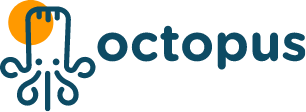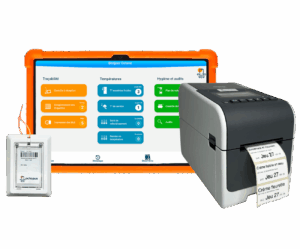Easily perform your HACCP records in the fish market!
Summary
- Simply implementing HACCP in the fishmonger’s shop?
- Traçabilité, les règles d’hygiène importantes en poissonnerie
- The cold chain, a crucial health standard in the fishmonger’s shop
- Table summarizing storage temperatures in a fishmonger’s shop
- Handler hygiene and cleaning plan
- The dangers of Listeria monocytogenes and Histamine
Need to implement HACCP in your fish shop easily?
We explain the essentials to guarantee hygiene and safety!
As a fishmonger, you are required to maintain impeccable hygiene to ensure food safety for your customers. You must notably complete training on the sanitary best practices to implement.
Here is the link to the GBPH (Guide to Good Hygiene Practices) for fishmongers:
GBPH Fishmongery.
The HACCP method is the most recommended solution to enforce all these hygiene rules.
Indeed, in fishmongery you handle, process, or sell food products, so you must control the risks and hazards related to your production.
HACCP is the method to set up and carry out self-monitoring adapted to the risks and hazards linked to your fishmonger activity.
To do so, you must ensure:
- Traceability of your products from purchase to sale,
- The cold chain,
- Good hygiene and maintaining a cleaning plan.
Fishmongers must also ensure their teams are trained on HACCP standards and enforce compliance.
Traceability and important hygiene rules in fishmongering ?
You must be vigilant about following food hygiene standards during:
- Upstream traceability: receiving goods (fish, shellfish, tartares, etc.).
Mandatory information: name and address of suppliers, delivery dates, and nature of received products.
Recommended information:- Product batch numbers,
- Volumes and quantities,
- Description of products (pre-packaged or not, etc.).
- Internal traceability: in fishmongering, foodstuffs require more product information than other food trades.
Your product labels must mention the name of the fish, the Latin name of the species, the production method, its place of capture or farming, the minimum durability date (MDD) or expiration date (ED) for processed products, the mention “defrosted” if applicable, and allergen risks for processed products (this list is not exhaustive).
- Downstream traceability: delivery of products to professional clients.
If you deliver to professional clients, you must identify them and be able to retrieve the list of products (including batch number, expiration date, or MDD) delivered to them.
Mandatory information:
-
- Name and address of suppliers, delivery dates, and nature of delivered products,
- You have a traceability obligation on all your products. During an inspection, you must present all information allowing product identification.
Download our complete HACCP guide for fishmongering
You will find all the useful documents such as:
- 1 PDF chart to record your checks
- 1 Excel spreadsheet to create your cleaning plan
- 2 educational sheets
The Cold Chain, a Crucial Sanitary Standard in Fishmongering ❄️
Health regulations do not specify exact expiration dates (DLC) for fresh fish, but they do set temperature requirements for the refrigeration and freezing of seafood products.
Proper handling of fish and respect for the cold chain are therefore the main factors influencing shelf life.
Here is a summary table of storage temperatures for seafood products.
Summary table of storage temperatures in a fishmonger’s shop

Save time on recordings with our wireless temperature loggers ?
- Automatic temperature recordings
- Wireless
- SMS and email alerts in case of anomalies
Hygiene of handlers and cleaning plan ?
Hygiene of handlers
Your personal hygiene, cleanliness of your clothing, and handwashing are key points in handler hygiene in fishmongering.
To achieve this, your premises must include changing rooms and a sufficient number of handwashing stations for your entire team.
The goal is to limit the introduction of germs from the handler.
Cleaning and disinfection plan
For the premises, ensure to establish a cleaning and disinfection plan compliant with regulations. You can build your cleaning and disinfection plan using our cleaning plan guide and download tables in PDF and Excel formats.
All equipment and utensils that come into contact with foodstuffs must be kept clean and maintained at all times to allow effective cleaning and, to prevent food contamination, adequate disinfection.
Dangers of Listeria monocytogenes and Histamine ?
The dangers come from the raw materials they contain, and two hazards must be especially considered: Listeria monocytogenes and histamine.
Listeria monocytogenes
Listeriosis is a disease caused by Listeria monocytogenes, a bacterium very resistant in the external environment, with an optimal growth temperature between 30 and 37 °C. It is heat-sensitive and can be destroyed after 30 minutes of cooking at 63 °C.
Listeria monocytogenes is widely present in the environment. It can be found in soil, water, plants, and many animal reservoirs.
Unlike most other bacteria, it is psychrophilic, meaning it can grow at low, even very low temperatures. This is why it is also present in refrigerators and freezers. Therefore, remember to regularly clean and disinfect your cold storage units.
Mode of contamination by Listeria
Contamination by Listeria is mainly foodborne: seafood, but also dairy products—especially raw milk cheeses—certain cold cuts, and vegetables.
Since it is heat-sensitive, it is generally absent from cooked foods and canned products, unless contamination occurs after cooking. Due to its ability to multiply at low temperatures, Listeria is often found in refrigerated foods with long shelf lives.
Histamine
In small doses, histamine is necessary for the proper functioning of our immune system (it is naturally stored in immune cells which release it when an allergen is present).
However, it can trigger a severe allergic reaction when consumed in high doses. This is why histamine poisoning is also called “pseudo-allergic food syndrome.”
Ingesting foods containing high doses of histamine, such as certain fish or cheeses, can cause a reaction resembling anaphylaxis (severity proportional to the amount ingested), which can lead to histamine shock.
Here are the main categories of concerned foods:
- Fish from the Scombridae family: tuna, bonito, mackerel, etc. These fish contain high levels of free histidine,
- Other fish: herring, sardine, anchovy, etc.,
- Certain cheeses depending on their composition and manufacturing process,
- Chocolate,
- Certain fermented products (wine, beer, sauerkraut, etc.).
Because histamine production is bacterial in origin, the cold chain (from production or capture to consumption) must be strictly respected, especially since histamine is not destroyed by cooking.
Some precautionary measures
Histamine formation in fish depends on the temperature at which it is stored from capture to consumption.
Therefore, to avoid histamine poisoning, it is very important to respect the cold chain and keep products below 2 °C.
Cooking or any other heat treatment, such as smoking or canning, does not destroy histamine.



